Diamond Carat
Carat is the term used to describe the weight of any gemstone, including diamonds. Although the definition of a carat has changed over time, since 1913 the international standard has been 200 milligrams, or 1/5 of a gram.
Diamonds can range in size from a fraction of a carat to several carats. Given the rarity of large stones, however, the price increases rapidly with size; therefore, a single 2-carat diamond will cost much more than two 1-carat diamonds. Very large diamonds with good color and clarity are very rare.
Below is the IDT Diamond Color Chart with definitions
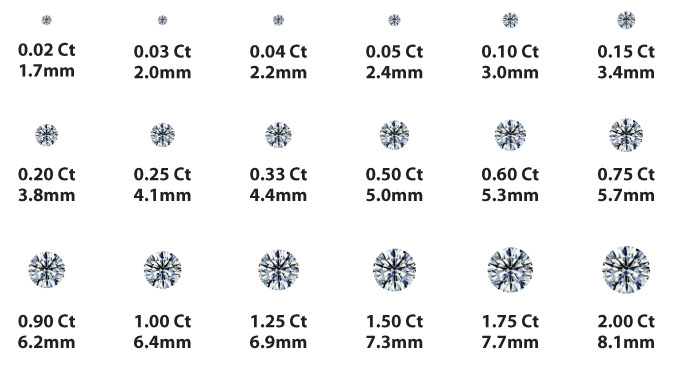
Diamond Color
Diamonds come in a variety of colors, some of them highly prized (pinks, blues, even yellow). However in a white diamond, the presence of a yellow tint will lower the price of a diamond. The less body color in a white diamond, the more true color it will reflect, and thus the greater its value. IDT grades diamonds on a scale of D to N.
Below is the IDT Diamond Color Chart with definitions
| Colorless | 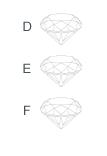 |
While there are differences in color between D, E, and F diamonds, they can be detected only by a gemologist in side by side comparisons, and rarely by the untrained eye. D-F diamonds should only be set in white gold / platinum. Yellow gold reflects color, negating the diamond's colorless effect. |
| Near Colorless | 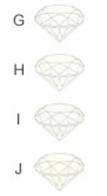 |
While containing traces of color, G-J diamonds are suitable for a platinum or white gold setting, which would normally betray any hint of color in a diamond. Because I-J diamonds are more common than the higher grades, they tend to be a great value. An I-J diamond may retail for half the price of a D diamond. Within the G-J range, price tends to increase 10-20% between each diamond grade. |
| Faint Color | 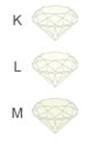 |
Beginning with K diamonds, color (usually a yellow tint) is more easily detected by the naked eye. Set in yellow gold, these warm colored diamonds appeal to some, and are an exceptional value. Others will feel they have too much color. Due to its perceptible color tint, a K diamond is often half the price of a G diamond. |
| Light Color | 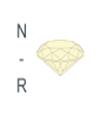 |
Diamonds in the N-R color range have an easily seen yellow or brown tint, but are much less expensive than higher grades. Lumera does not carry diamonds in this color range due to a lack of demand. If you desire a diamond in this range, request a price quote using the custom diamond search. |
Diamond Clarity
Diamond clarity is a quality of diamonds relating to the existence and visual appearance of internal characteristics of a diamond called inclusions, and surface defects called blemishes. Clarity is one of the four Cs of diamond grading, the others being carat, color, and cut.
Below is the IDT Diamond Clarity Chart with definitions
| FL IF |
Flawless: No inclusions or blemishes are visible to a skilled grader using 10x magnification. Internally Flawless: No inclusions, only blemishes are visible to a skilled grader using 10 x magnifications. |
Extremely rare, less than 1 in 5000 jewelry quality diamonds are rated FL. FL and IF diamonds appear identical unless viewed under 10 x magnification by a skilled grader. Less than 3% of jewelry quality diamonds are rated IF. |
| VVS1 VVS2 |
Very, Very Slightly Included: Inclusions are difficult for a skilled grader to see under 10 x magnification. | VVS1 inclusions are typically only visible from the pavilion, while VVS2 inclusions are visible from the crown. In each, the inclusions are invisible to the eye, appearing identical to the higher grades unless viewed under 10 x magnifications by a skilled grader. |
| VS1 VS2 |
Very Slightly Included: Inclusions are clearly visible under 10x magnification but can be characterized as minor. | VS1 Inclusions are not visible to the naked eye. Perhaps 1 in 100 untrained observers can detect VS2 inclusions with the naked eye, on close inspection under ideal conditions. |
| SI1 SI2 |
Slightly Included: Inclusions are noticeable to a skilled grader using 10x magnification. | SI1 is the lowest grade with flaws often invisible to the naked eye. SI2 inclusions are usually visible to the naked eye, although they will require close inspection. |
| I1 I2 I3 |
Included: Inclusions are obvious under 10x magnification and may affect transparency and brilliance. | I1 diamonds have inclusions that are almost always visible to the naked eye. Because I2-I3 diamonds have prounounced inclusions, and in the case of I3 may even affect the diamond's durability, they are not offered by Lumera. |
Diamond Cut
A diamond cut is a style or design guide used when shaping a diamond for polishing such as the brilliant cut. The cut of a diamond greatly affects a diamond's brilliance; this means if it is cut poorly, it will be less luminous.
Below is the IDT Diamond Cut Chart with definitions
| Round Brilliant cut | 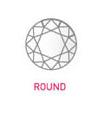 |
This is referred to as the archetypical brilliant cut that features a total of 58 facets which is the optimal number that is used to achieve maximum light return. |
| Oval Brilliant Cut | 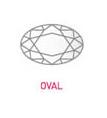 |
This is a narrower and longer version of the round brilliant cut. |
| Marquise Diamond Cut | 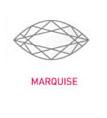 |
This is one of the types of diamond cuts that are similar to an oval shape. It can be described as an elongated version of the round option but features more pointed ends. This is a great shape that is used to make a persons finger appear as though they are thing and long. |
| Pearl Diamond Cut | 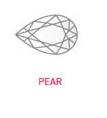 |
This also has 58 facets like the round brilliant cut but usually has varying proportions. It is quite similar to the marquise and oval shapes but comes with a soft and round edge. |
| Heart Diamond Cut |  |
This is one of the most romantic types of diamond cuts in the market. Forming the shape perfectly is normally a difficult task as all the lobes have to be totally symmetrical to achieve diamond brilliance. |
| Trilliant Diamond Cut | 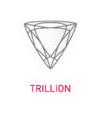 |
This is a triangular shaped diamond that is normally used to enhance larger stone centers working as side stones. |
| Emerald Cut | 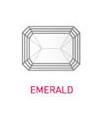 |
This is a rectangular shaped stone that has an open and large table which offers additional clarity. |
| Baguette Cut |  |
This is used as stone whose main purpose is to accentuate a larger piece of center stone. |
